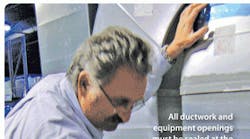The Leadership in Energy and Environmental Design (LEED®) rating system has quickly become the industry benchmark for a building's sustainability and energy performance. More and more owners, corporations and developers are choosing to register their buildings under one of the various LEED rating systems. Governmental agencies are beginning to mandate LEED certification for all of their new buildings as well as their existing portfolio of buildings.
The relatively recent popularity to pursue LEED has created the need for education on the various LEED credit categories, the LEED certification process and green building strategies in general. Mechanical contractors are a key participant in the construction of green buildings and must understand their role in the process to maximize their potential. To promote their knowledge of the LEED rating system and their ability to perform on a LEED project mechanical contractors are beginning to staff up with LEED Accredited Professionals. LEED Professional Credentials demonstrate current knowledge of green building technologies, best practices, and the rapidly evolving LEED Rating Systems.
LEED® Green Associate Credential
The LEED Green Associate credential demonstrates general green building knowledge. The LEED Accredited Professional (AP) credential demonstrates a comprehensive knowledge of the LEED rating system. The LEED Fellow credential will distinguish an extraordinary class of leading professionals.
To become credentialed individuals must first apply for the credentialing exams. Applicants pursuing the LEED® Green Associate title must meet one of the three requirements:
- document involvement with a LEED registered project
- employment (or previous employment) in a sustainable field of work
- attendance in a green building seminar.
Applicants pursuing the LEED® AP title must demonstrate LEED project experience within the previous three years to sit for the exam. The requirements to become a LEED® Fellow are still under development at this time.
Indoor Air Quality Management
IAQ during construction can be the most intensive credit for a mechanical contractor. It requires adherence to an IAQ management plan during both demolition phases and construction phases. All ductwork and equipment openings must be sealed at the factory/shop to prevent collection of construction dust. Return grilles must be covered with MERV 8 filters, if permanently installed HVAC units are used for heating, cooling, and ventilation during demolition or construction activities. Materials stored onsite must be protected from moisture and located apart from mechanical rooms during construction. The mechanical contractor must also document compliance with the IAQ management plan by taking photos at different stages of construction.
Company Marketing
Mechanical contractors can market themselves as the "green contractor" in a number of ways. Some examples are:
- Develop a diverse group of LEED APs.
- Maintain credentials by attending continuing educational courses.
- Become active with the United States Green Building Council, in national and local chapters.
- Pursue LEED for the company’s facility.
- Purchase green-e power from utility company (http://www.green-e.org/).
- Install renewable energy systems.
- Perform an energy audit of your company’s facility to find ways to save energy. This isn't an exhaustive list. The number of ideas that can help you become known as the "go-to green contractor" is endless.
Product Selection
Equipment vendors play an important role in the LEED process. Selecting, installing, and correct documentation of the purchased product is critical to the success of the pursued credit. Regardless of claims by product literature the product alone does not achieve credits. Mechanical product selection can’t achieve credits within the materials and resources category. Before purchasing equipment ,consult with the LEED reference guide for direction.
Act Now or Be Left Out
LEED has become extremely popular very quickly. Contractors who do not get educated on the process toward LEED certification and the various LEED rating systems may find themselves left off pre-qualification bid lists. The goal of the U.S. Green Building Council is transform the market. They don't want us to ask the question "Should we pursue LEED?" They want us to ask the question "To what level of LEED should we pursue?" As mechanical contractors we need to help integrate this transformation.
MECHANICAL CONTRACTOR LEED CREDITS
The LEED rating systems include prerequisites and credits. Prerequisites must be achieved and have been included within the LEED rating systems to ensure a minimum level of sustainability. The current version of LEED includes three types of credit categories – Core, Innovation and Regional Priority. Core categories provide project teams with a prescriptive path toward credit achievement.
Core categories include: Sustainable Sites, Water Efficiency, Energy and Atmosphere, Materials and Resources, and Indoor Environmental Quality.
The Innovation category rewards projects for innovative building features and exemplary performance.
Regional priority credits award project teams who implement regionally specific environmental green building strategies. Mechanical contractors can contribute to the each category, however the most intensive LEED categories for mechanical contractors are the Energy and Atmosphere category and the Indoor Environmental Quality category.
The mechanical systems must be installed as instructed within the basis of design created by the design team. The mechanical systems will also be commissioned to verify they are installed and operating as the designer intended. It's the responsibility of the mechanical contractor to comply with the design documents and remedy inconsistencies found by the commissioning authority.
Prior to bidding LEED projects, it's advised that the contractor review the commissioning requirements, in order that data collection and pre-functional testing costs will be covered in mechanical proposals. — DH
David Hubka is the sustainable project manager at Total Mechanical, Inc., Pewaukee, WI. His responsibilities include building energy simulation modeling, facility energy audits, commissioning, and LEED® project documentation. He was one of the first 10 LEED® Green Associates in the world.








